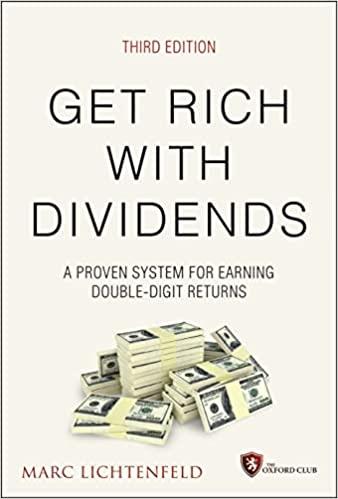Question
Assume that you recently graduated and landed a job as a financial planner with Cicero Services, an investment advisory company. Your first client recently inherited
Assume that you recently graduated and landed a job as a financial planner with Cicero Services, an investment advisory company. Your first client recently inherited some assets and has asked you to evaluate them. The client presently owns a bond portfolio with $1million invested in zero coupon Treasury bonds that mature in 10 years. The client also has $2 million invested in the stock of Blandy, Inc., a company that produces meat-and- potatoes frozen dinners. Blandys slogan is, Solid food for shaky times. Unfortunately, Congress and the President are engaged in an acrimonious dispute over the budget and the debt ceiling. The outcome of the dispute, which will not be resolved until the end of the year, will have a big impact on interest rates one year from now. Your first task is to determine the risk of the clients bond portfolio. After consulting with the economists at your firm, you have specified five possible scenarios for the resolution of the dispute at the end of the year. For each scenario, you have estimated the probability of the scenario occurring and the impact on interest rates and bond prices if the scenario occurs. Given this information, you have calculated the rate of return on 10-year zero coupon for each scenario. The probabilities and returns are shown below:
| Scenario | Probability of Scenario | Return on a 10 year Zero coupon treasury bond during the next year |
| Worst case | .10 | -14% |
| Poor Case | .20 | -4% |
| Most Likely | .40 | 6% |
| Good Case | .20 | 16% |
| Best Case | .10 | 26% |
You have also gathered historical returns for the past 10 years for Blandy, Gourmange Corporation (a producer of gourmet specialty foods), and the stock market. Historical Stock Returns
| Year | Market | Blandy | Gourmange |
| 1 | 30% | 26% | 47% |
| 2 | 7 | 15 | -54 |
| 3 | 18 | -14 | 15 |
| 4 | -22 | -15 | 7 |
| 5 | -14 | 2 | -28 |
| 6 | 10 | -18 | 40 |
| 7 | 26 | 42 | 17 |
| 8 | -10 | 30 | -23 |
| 9 | -3 | -32 | -4 |
| 10 | 38 | 28 | 75 |
Market Blandy Gourmange
Average return: 8% ? 9.2%
Standard Deviation: 20.1% ? 38.6%
Correlation with the market: 1.00 ? 0.678
Beta: 1.00 ? 1.30
The risk-free rate is 4% and the market risk premium is 5%.
Questions A: Your client is shocked at how much risk Blandy stock has and would like to reduce the level of risk. You suggest that the client sell 25% of the Blandy stock and create a portfolio with 75% Blandy stock and 25% in the high-risk Gourmange stock. How do you suppose the client will react to replacing some of the Blandy stock with high- risk stock? Show the client what the proposed portfolio return would have been in each of year of the sample. Then calculate the s average return and standard deviation using the portfolios annual returns. How does the risk of this two-stock portfolio compare with the risk of the individual stocks if they were held in isolation?
B: (1) Should portfolio effects influence how investors think about the risk of individual stocks? (2) If you decided to hold a one-stock portfolio and consequently were exposed to more risk than diversified investors, could you expect to be compensated for all of your risks; that is, could you earn a risk premium on that part of your risk that you could have eliminated by diversifying?
C: According to the Capital Asset Pricing Model, what measures the amount of risk that an individual stock contributes to a well-diversified portfolio? Define this measurement.
D: What is the security Market Line (SML)? How is beta related to a stock's required rate of return?
E: Calculate the correction coefficient between Blandy and the market. Use this and the previosly calculated (or given) standard deviations of Blandy and the market to estimate Blandy's beta. Does Blandy contribute more or less risk to a well-diversified portfolio than does the average stock? Use the SML to estimate Blandy's required return.
F: (1) Suppose the risk-free rate goes up 7%. What effect would higher interest rates have on the SML and on the returns required on high - and low-risk securities? (2) Suppose instead the investor's risk aversion increased enough to cause the market risk premium to increase to 8%. (Assume the risk-free rate remains constant.) What effect would this have on the SML and on returns of high and low-risk securities?
G: Your client decides to invest $1.4 million in Blnady stock and $0.6 million in Gourmange stock. What are the weights for this portfolio? What is the portfolio's beta? What is the required return for this portfolio?
Step by Step Solution
There are 3 Steps involved in it
Step: 1

Get Instant Access to Expert-Tailored Solutions
See step-by-step solutions with expert insights and AI powered tools for academic success
Step: 2

Step: 3

Ace Your Homework with AI
Get the answers you need in no time with our AI-driven, step-by-step assistance
Get Started


